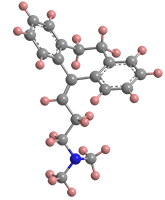What molecule am I?


Amitriptyline is a tricyclic molecule with a cycloheptane ring in the center and an amino group in the sidechain. It is an antidepressant that was developed by Merck (Rahway, NJ) in the 1950s and approved by the US Food and Drug Administration in 1961. It was originally sold under the trade name Elavil.
In addition to major depressive disorders, amitriptyline is used to treat chronic pain conditions, including neuropathy, fibromyalgia, migraine, and tension headache. Its mode of action is to increase the availability of monoamines in the central nervous system postsynaptic clefts.
Today the drug’s numerous and sometimes severe side effects make it a second-line treatment for these disorders. Among its more serious side effects are blurred vision, tachycardia, fatigue, suicidal thoughts among young people, overdose, and dependence.
In 2021, T. Umaharan*, S. Sivayokan, and S. Sivansuthan at Jaffna Teaching Hospital (Sri Lanka) published a case report and literature review of amitriptyline dependence. The authors confirmed that vulnerable individuals are subject to dependence on the drug and suggest that “a clear protocol should be implemented when dispensing medications from pharmacy to patients.”
Amitriptyline hazard information*
| Hazard class** | GHS code and hazard statement | |
|---|---|---|
| Acute toxicity, oral, category 3 | H301—Toxic if swallowed | |
| Acute toxicity, dermal, category 3 | H311—Toxic in contact with skin | |
| Serious eye damage/eye irritation, category 1 | H318—Causes serious eye damage | |
| Acute toxicity, inhalation, category 3 | H331—Toxic if inhaled | |
| Specific target organ toxicity, single exposure; narcotic effects, category 3 | H336—May cause drowsiness or dizziness | |
| Reproductive toxicity, category 2 | H361—Suspected of damaging fertility or the unborn child | |
| Reproductive toxicity, effects on or via lactation | H362—May cause harm to breast-fed children | |
| Short-term (acute) aquatic hazard, category 1 | H400—Very toxic to aquatic life | |
| Long-term (chronic) aquatic hazard, category 1 | H410—Very toxic to aquatic life with long-lasting effects | |
*Compilation of multiple safety data sheets.
**Globally Harmonized System (GHS) of Classification and Labeling of Chemicals. Explanation of pictograms.
Molecules in the News
Diisononyl phthalate1 (DINP) and diisodecyl phthalate2 (DIDP) are branched long-chain phthalic acid3 esters that are widely used as plasticizers to make hard plastics such as poly(vinyl chloride)4 softer and more flexible. Originally developed in the 1950s and 1960s, these plasticizers and others have come under scrutiny in recent years for being possible carcinogens and for causing other health problems.
This May, the US Environmental Protection Agency completed a draft review of risk evaluations for DINP and DIDP that had mixed findings. EPA’s preliminary results indicated that:
- DINP has a greater chance of causing liver damage than DIDP.
- DINP in high concentrations can cause cancer, whereas DIDP poses no cancer risk.
With one exception, the agency gave DIDP a clean bill of health for all uses.
1. CAS Reg. No. 28553-12-0.
2. CAS Reg. No. 26761-40-0.
3. CAS Reg. No. 88-99-3.
4. CAS Reg. No. 9002-86-2.
Molecules in the News
MOTW highlights molecules that appear in major news outlets. See this week's edition.
This molecule was suggested by a reader. We present almost all of the molecules suggested by our readers. If you have a molecule you would like us to consider, please send us a message. And thank you for your interest in Molecule of the Week! —Ed.
Amitriptyline fast facts
| CAS Reg. No. | 50-48-6 |
| SciFindern name | 1-Propanamine, 3-(10,11-dihydro- 5H-dibenzo[a,d] cyclohepten-5-ylidene)-N,N-dimethyl- |
| Empirical formula | C20H23N |
| Molar mass | 277.40 g/mol |
| Appearance | White crystals or powder |
| Melting point | 196–197 °C |
| Water solubility | 10 mg/L (25 °C) |

Learn more about this molecule from CAS, the most authoritative and comprehensive source for chemical information.
Molecule of the Week needs your suggestions!
If your favorite molecule is not in our archive, please send us a message. The molecule can be notable for its current or historical importance or for any quirky reason. Thank you!
Stay Ahead of the Chemistry Curve
Learn how ACS can help you stay ahead in the world of chemistry.

